Posted May 01, 2019 in Breast Implants
Once you have decided that you wish to undergo breast augmentation, you will likely start researching your options. This can get confusing quickly, as there is a lot of information out there and every doctor has his or her own opinion. Here we will discuss the many options you have, and Dr. Friedman’s recommendations to get the results you desire.
What Is the Right Size?
Determining the “right” breast implant size can be a major challenge. Let us explain the most frequent methods and their pitfalls:
Going by bra cup size
“I’m an A cup, and I want to be a full C cup.” The problem: There is no standardization of cup size among bra manufacturers. A Playtex B is frequently a Victoria’s Secret C. A woman who fits a 34 D cup may also fit a 36 C. So cup size is imprecise, at best, and sometimes closer to a guess.
Relying on a surgeon’s determination of the “correct” size based on breast measurements
It has become popular among breast implant surgeons to measure the width of the base of the breast, find an implant with the same diameter (based on a chart provided by the implant manufacturers), and then tell the patient that this is the magical “right size.” Although this is reasonable anatomically, your wishes regarding breast size are much more important than the surgeon’s. While a surgeon can and should provide guidance regarding implant size, the ultimate choice should be yours. If your “right” size is different from his, your surgeon should be flexible, rather than mindlessly following a chart.
Stuffing your bra with different sizes of implants until you find the right one
This is great for marketing purposes. You get to try on different implants until you find the right size. The problem is that the actual implants go under the breast tissue, not over them. Superimposing the implants on top of your breasts creates a snowman effect (one sphere stacked on top of the other), which exaggerates the projection of the breasts relative to what will actually happen in the operating room. Women often choose implants that are smaller than they actually wanted when they use this method.
Before (actual patient)
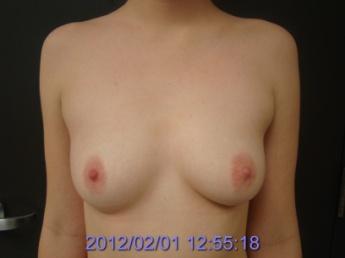
After (actual patient)
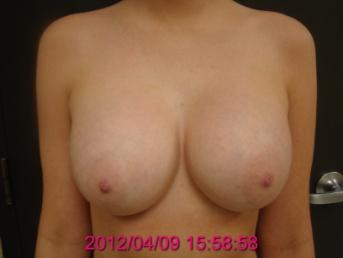
What Does Dr. Friedman Do in His Breast Augmentation Practice?
He thinks in terms of implant volumes: 330 cc, 360 cc, 390 cc, etc. You think in terms of cup sizes. Neither of these allows effective communication, so he uses the one thing you can both see: photos.
You can choose from among the breast augmentation before and after photos on our website, among the hundreds of photos in our office photo albums, or among any photos from any magazine or internet site. Although you might not know the cup size of the women you choose or the number of ccs, it really doesn’t matter. You simply look through breast photos and categorize them as “too big,” “too small,” or “about right.” Dr. Friedman will analyze the photos with you. As long as your choices are reasonable for your frame, the choice of size is yours. Dr. Friedman believes that there is a range of acceptable sizes rather than a specific right size. Photos of desired breast size don’t work perfectly, but they work better than anything else he has tried. This method, along with Dr. Friedman’s artistic eye, can help you get the look you desire.
Saline or Silicone?
Advantages of silicone implants:
- These implants are softer to the touch and feel more like breast tissue. Silicone gel is an oil, similar to the fatty tissues of the breasts. Saline is simply saltwater.
- It offers reduced rippling relative to saline implants. All implant edges ripple. Try putting water in a freezer bag and look at the edges. You will definitely see less rippling with oil in a bag than with water.
- Preliminary studies suggest that silicone gel implants may last longer than saline implants.
Advantages of saline implants:
- Saline implants require smaller incisions. Dr. Friedman typically uses an incision that is less than one inch long for saline implants. Since silicone gel implants are pre-filled by the manufacturer, they require a 1.5 to 2-inch incision.
- A lower risk of capsular contracture (hardening of the implants due to constricting scar tissue).
- Saline implants are usually lower in cost (around $1,300 lower).
- There is less controversy.
Bottom line: there is no perfect answer. If there were, we’d only be discussing one type of implant.
So which one should you choose?
Silicone implants are probably better from a purely cosmetic standpoint, as they feel very similar to breast tissue.
Saline implants are probably better from a safety standpoint, as it’s hard to argue with the safety of a bag of saltwater.
In general, if you have a reasonable amount of breast tissue, subcutaneous fat, and breast tone, saline implants will be reasonably well-camouflaged and may be a good choice.
On the other hand, if your breasts are very small, you are extremely thin, and/or have poor breast tone (i.e., you don’t have much tissue to cover your implants), you may want to consider silicone gel.
Silicone gel: BEFORE Saline: BEFORE ![]()
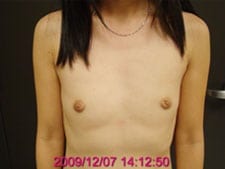
Silicone gel: AFTER Saline: AFTER ![]()

Where Should My Breast Implants Be Placed?
If a woman has not undergone prior breast surgery, Dr. Friedman places the vast majority of implants below the chest muscle. Why? Because submuscular breast implants have the following advantages:
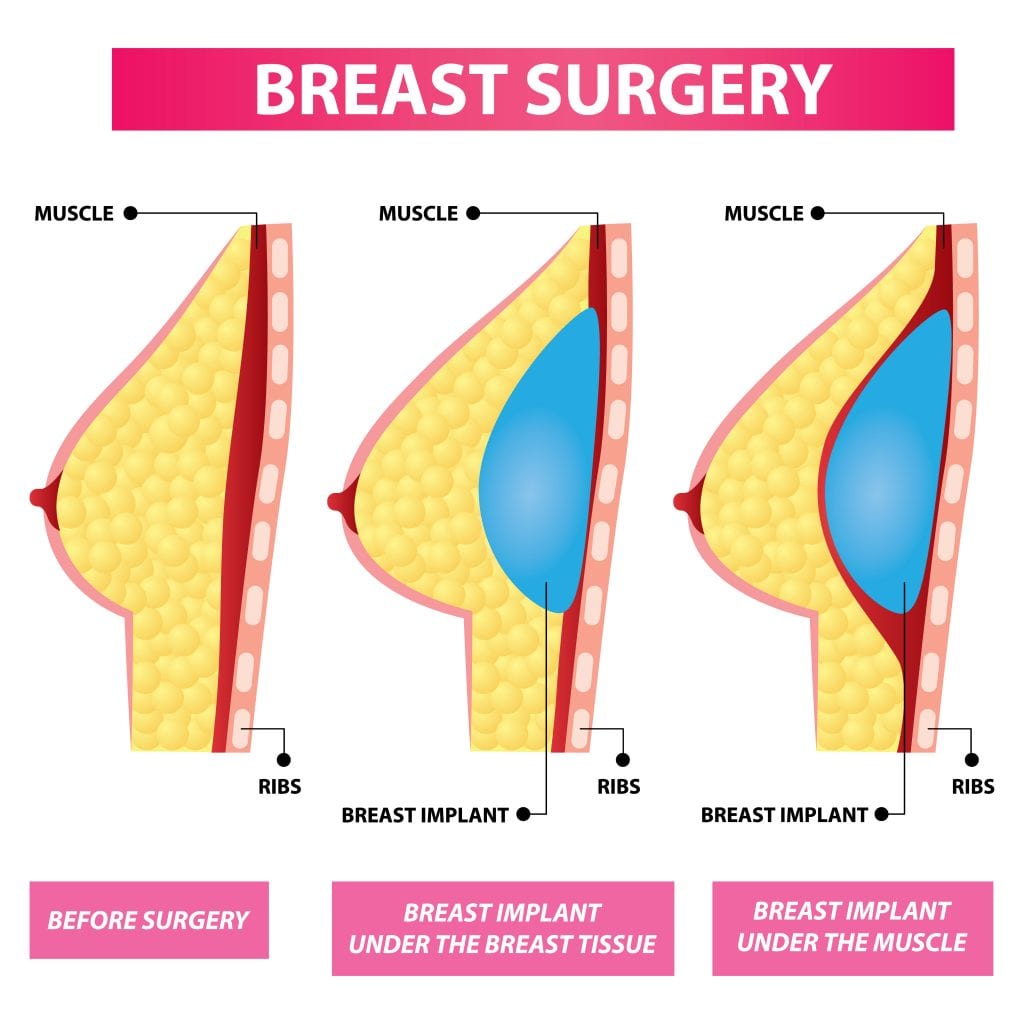
- Reduced risk of capsular contracture: The scar tissue around the breast implants is less likely to become excessively tight if it is being stretched constantly by the motion of the overlying muscle.
- Reduced risk of interference with mammograms: Although any breast implant may interfere with mammograms, the muscle can be used as a divider to separate the overlying breast tissue from the underlying subpectoral implant.
-
- Reduced risk of “bottoming out”: Breast implants placed below muscle are supported by the overlying muscle. In contrast, implants placed above the muscle (subglandular breast implants) are supported only by the overlying skin and breast tissues.
- Reduced risk of visible implant rippling: All breast implants ripple along their edges. Saline breast implants ripple more than silicone gel breast implants. With submuscular placement, the upper inner two-thirds of the implants are covered by the chest muscle, significantly reducing the extent of rippling.
- Reduced risk of unnatural bulging of the upper breasts: The chest muscle blunts the junction of the upper implant edge and the chest wall, generally yielding a more natural breast appearance.
BEFORE Subglandular (above the muscle with capsular contracture) AFTER Subpectoral (below the muscle) 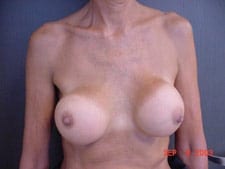
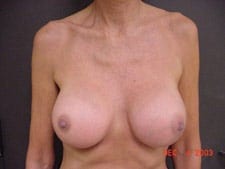
On the downside, placing implants below the muscle requires greater surgical time, effort, and skill and usually results in more immediate postoperative discomfort. In athletes, implants below muscle may sometimes weaken the muscle, and the implants may “jump” with forceful muscle contraction. In Dr. Friedman’s two-plus decades of private practice, however, the advantages of subpectoral implant placement have far outweighed the disadvantages in the vast majority of women.
Implant Texture
All breast implants have an outer shell that is made from solid silicone. As the name implies, smooth implants have a smooth, slick surface. Textured implants have a rough, clingy surface.
Right after breast augmentation surgery, most implants look too high and too tight. Dr. Friedman likes to joke with patients that their implants will look like decorative shelving for the first couple of weeks. Over the course of the first month or two, the implants typically drop and look more natural, though final results do not appear for about one year.
Smooth breast implants are “slippery,” and their weight will cause them to fall after surgery. This is desirable when the implants are placed below the pectoralis major (chest) muscle, and the muscle has adequate bulk to hold up the implants. As a result, smooth implants are used in the majority of routine submuscular breast augmentations.
Textured breast implants tend to cling to the surrounding tissues, making them more resistant to falling after surgery. This can be good for women whose breasts and/or chest muscles provide inadequate implant support. Textured implants placed in a subglandular (above the muscle) position are also associated with a mildly lower risk of capsular contracture (excessive firmness of the implants) than smooth implants placed above the muscle.
So which type is better? Dr. Friedman uses smooth implants for about 97 percent of breast augmentations. But he always has textured implants available, as you never know when you might need them.
Implant Profiles
Round breast implants come in a variety of sizes. They also come in different “profiles.” The profile describes the ratio of the projection of the implant (how far it sticks out) to the diameter of the implant (how wide it is).
| Implant Profile | Implant Projection | Implant Diameter |
| Low | Small | Wide |
| Moderate | Moderate | Moderate |
| High | Large | Narrow |
In most patients, a moderate profile breast implant (moderate projection, moderate diameter) provides a natural look. This is Dr. Friedman’s preference in the vast majority of breast augmentation surgeries.
However, in patients with very narrow chests who desire very large implants, a high profile breast implant (large projection, narrow diameter) may be a reasonable choice, though it may project enough to look a bit artificial.
The easiest way to understand this is with an analogy to home building:
Moderate-profile implant: If you have a medium-sized piece of land, then a one-story house with 10-foot ceilings will work fine.
High-profile implant: If you have a very small lot, then you compensate by building a small square-footage house that has 20-foot ceilings in the living room.
In rare patients who have a wide chest wall and desire a relatively small implant, a low profile breast implant (small projection, large diameter) may be worth considering. (This is analogous to a sprawling one-story ranch house with low ceilings.)
Feel free to call our office at (469) 467-0100 or fill out our online contact form to schedule a consultation or if you have any more questions about breast implants.